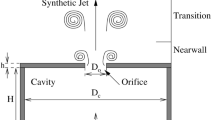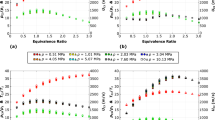Abstract
This paper presents the numerical analysis of rudder cavitation in propeller slipstream and the development of a new rudder system aimed for lift augmentation and cavitation suppression. The new rudder system is equipped with cam devices which effectively close the gap between the horn/pintle and movable wing parts. A computational fluid dynamics code that solves the Reynolds-averaged Navier–Stokes equations is used to analyze the flow field of various rudder systems in propeller slipstream. The body force momentum source terms that mimic flow field behind a rotating propeller are added in the momentum equations to represent the influence of the propeller and its slipstream. For detailed explication of the new rudder system’s lift augmentation and cavitation suppression mechanism, three-dimensional flow analysis is carried out. Simulations clearly display the mechanism of the lift augmentation and cavitation suppression. The computational results suggest that the Reynolds-averaged Navier–Stokes-based computational fluid dynamics reproduces the flow field around a rudder in propeller slipstream and that the present concept for a cavitation suppressing rudder system is highly feasible and warrant further study for inclusion of the interaction with hull and mechanical design for manufacturing and operations.






















Similar content being viewed by others
References
Shen YT, Jiang CW, Remmers KD (1997) A twisted rudder for reduced cavitation. J Ship Res 41(4):260–272
Boo GT, Song IH, Shin SC (2003) Numerical simulation for the rudder in order to control the cavitation phenomena. In: Proceedings of the international workshop on frontier technology in ship and ocean engineering, Seoul, Korea
Hwang Y-S, Park J-J (2004) A numerical simulation of 2D viscous flows around rudder sections considering section type and gap shape. In: Proceedings of the annual spring meeting of the society of naval architects of Korea, Chungmu, Korea (in Korean)
Molland AF, Turnock SR (1992) Wind tunnel investigation of the influence of propeller loading on ship rudder performance. Trans Royal Inst Naval Architects 35:105–120
Suzuki H, Toda Y, Suzuki T (1993) Computation of viscous flow around a rudder behind a propeller: laminar flow around a flat plate rudder in propeller slipstream. In: Proceedings of the 6th international conference on numerical ship hydrodynamics, Iowa City, IA
Singhal AK, Athavale MM, Li HY, Jiang Y (2002) Mathematical basis and validation of the full cavitation model. ASME J Fluids Eng 124(3):617–624
Shih T-H, Liou WW, Shabbir A, Yang Z, Zhu Z (1995) A new k–ε eddy-viscosity model for high Reynolds number turbulent flows—model development and validation. Comput Fluids 24(3):227–238
Kim S-E, Rhee SH (2002) Assessment of eight turbulence models for a three-dimensional boundary layer involving crossflow and streamwise vortices. AIAA Paper 2002–0852, Proc. 40th AIAA aerospace sciences meeting and exhibit, Reno, NV, USA
Rhee SH, Makarov B, Krishnan H, Ivanov V (2005) Assessment of volume of fluid method for free-surface wave flows. J Mar Sci Technol 10(4):173–180
Rhee SH, Makarov B (2005) Validation study for free-surface wave flows around surface-piercing cylindrical structures. In: Proceedings of the 24th international conference on offshore mechanics and arctic engineering, Halkidiki, Greece
Rhee SH, Joshi S (2005) Computational validation for flow around a marine propeller using unstructured mesh based Navier–Stokes solver. JSME Int J B 48(3):562–570
Hinze JO (1975) Turbulence, 2nd edn. McGraw Hill, New York
Singhal AK, Vaidya N, Leonard AD (1997) Multi-dimensional simulation of cavitating flows using a PDF model of phase change. ASME Paper FEDSM97-3272, Proc. ASME FED Meeting, Vancouver, Canada
Stern F, Kim HT, Patel VC, Chen HC (1988) A viscous-flow approach to the computation of Propeller–Hull interaction. J Ship Res 32(4):246–262
Hough G, Ordway DE (1965) The generalized actuator disk. Developments in theoretical and applied mechanics, vol 2. Pergamon Press, NY, USA, pp 317–336
Kim S-E, Mathur SR, Murthy JY, Choudhury D (1998) A Reynolds-averaged Navier–Stokes solver using unstructured mesh based finite-volume scheme. AIAA Paper 98-0231, Proc. 36th AIAA Aerospace Sciences Meeting and Exhibit, Reno, NV
Han JM, Kong DS, Song IH, Lee CS (2001) Analysis of the cavitating flow around the horn-type rudder in the race of a propeller. In: Proceedings of the 4th international symposium on cavitation CAV2001, Pasadena, CA
Rhee SH, Kim S-E, Ahn H, Oh J, Kim H (2003) Analysis of a jet-controlled high-lift hydrofoil with a flap. Ocean Eng 30(16):2117–2136
Choi B, Park H, Kim H, Lee S (2004) An experimental evaluation on the performance of high lifting rudder under coanda effect. In: Proceedings of the 9th international symposium on practical design of ships and other floating structures, Hamburg, Germany
Acknowledgments
This work was supported by the Korea Science and Engineering Foundation (KOSEF) grant funded by the Ministry of Science and Technology of the Korea government (No. ROA-2007-000-10028-0). It also should be acknowledged that the second author was supported partly by the Korea Research Foundation Grant (KRF-2005-005-J10203) funded by the Korean Government (MOEHRD). The authors also express their sincere gratitude to the late Dr. G. T. Boo of Samsung Ship Model Basin for providing valuable and helpful discussions.
Author information
Authors and Affiliations
Corresponding author
About this article
Cite this article
Rhee, S.H., Kim, H. A suggestion of gap flow control devices for the suppression of rudder cavitation. J Mar Sci Technol 13, 356–370 (2008). https://doi.org/10.1007/s00773-008-0013-6
Received:
Accepted:
Published:
Issue Date:
DOI: https://doi.org/10.1007/s00773-008-0013-6




